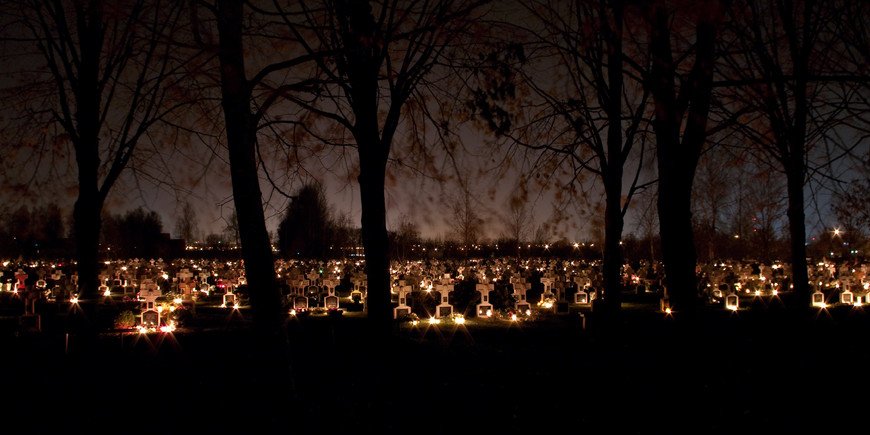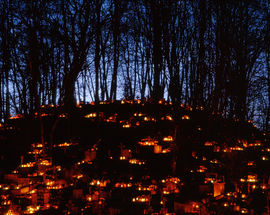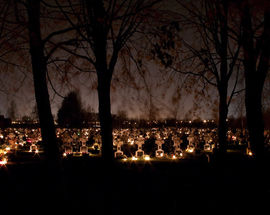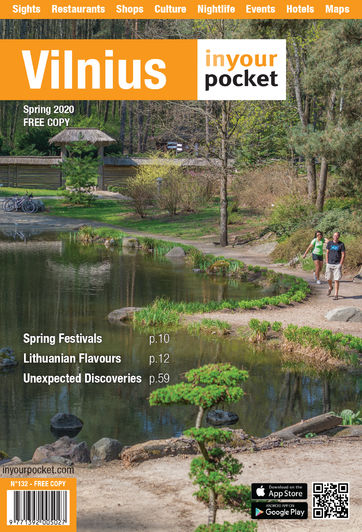In Lithuania, Vėlinės is, befitting the local character, an altogether more restrained and spiritual experience, and if you’re in Lithuania at that time we urge you to seek out a cemetery near you. Typically starting as darkness falls on November 1 and continuing during the day of November 2, Vėlinės is a tradition that goes back many centuries to pagan times, when Lithuanians set aside a special time in autumn, amid the fallen leaves, to honour dead relatives with spiritual rituals in a festival called Ilgės, which lasted for much of October.
During meals, families would have places set for departed members, and beggars would be given food and asked to pray for the souls of the dead. Even as the Ilgės tradition slowly evolved into All Souls’ Day, the belief persisted that souls returned to the realm of the living, to their homes, just for that time, and they were graciously received with generous suppers. White, soft beds were made for them. Blessed candles were lit either side of the pillow, and the family knelt close by, waiting.
Then they would hear cracking in the ceilings and floors, which meant that the dead souls had arrived.
In western Lithuania, the Curonians would go from the village churches straight to the tavern, where they brewed beer together, and women brought baskets filled with cold, baked fish. This was consumed without knives, with the windows and doors open wide, in silence.

Even in the early 20th century, in some of the remoter parts of Lithuania, food was taken to cemeteries at the beginning of November and left there.
In Dieveniškės, for example, a village south of Vilnius that is now tucked inside a peninsula of land surrounded on all sides by Belarus, the souls of the dead would be honoured on the first Saturday evening in October. Traditional foods were made, such as beetroot soup and buckwheat cake, which would be eaten only after midnight.
Buckwheat porridge was baked in a sheep’s stomach and a hen’s or rooster’s right leg or left wing, and these would be taken to a church as an offering.
As late as the 1940s, in northern Lithuania, a Feast of the Graves was celebrated in autumn. It was thought that those souls that did not ascend to heaven roamed about in the torment of perpetual darkness. So the candles on the graves lit the way.
Finally, a word of warning. Do not go walking on country or village roads as darkness falls on November 1. The roads, lanes and paths are filled with the souls of the dead of many centuries past. And there can be some mean souls.
Vilnius cemeteries
Deceptively isolated Rasos kapinės can be reached by strolling from the Old Town up Subačiaus and then Rasų Street. This waving terrain of crosses contains the graves of famous locals like Jonas Basanavičius, linguist and founder of the first Lithuanian-language newspaper Aušra. He lies close to the chapel, while uphill from the main entrance lies the tombstone of revered, mystical painter and composer M K Čiurlionis.
Next to entrance is a more controversial site, a plot for Polish leader Józef Piłsudski, the man responsible for annexing the Vilnius region to Poland in 1920. He was buried in Krakow, but his heart was cut out according to his wishes and buried in Vilnius, here in this tomb, in 1935.
Rasų Cemetery is beautiful at all times of the year but especially in the leafy autumn and at Vėlinės on November 1-2, when countless candles flicker across the hillside by night.
The biggest cemetery in central Vilnius is Antakalnio kapinės, which can be reached by bearing right from Antakalnio onto L Sapiegos Street, following it round and turning right on Kuosų. Elegantly carved headstones cover the rolling, tree-shrouded landscape, the crosses and tombs inscribed in Lithuanian, Russian and Polish.
Following the paved path, you’ll eventually see a series of identical stone crosses to the left. They are dedicated to Polish soldiers killed during World War I – as bloody and tragic a conflict in the east as it was in the west. Taking paths to the right will take you to broadly chiselled Soviet-era statues in the Socialist Realist style to poets and political leaders who were largely faithful to the party. Cut into a hill at the heart of the cemetery is a sweeping, semi-circular memorial to the 14 people who died defending the TV Tower and Parliament building in January 1991.
Perched on a high bank above the bubbling River Vilnia at the far end of the Užupis suburb is tranquil Bernardinų kapinės, tightly packed with lopsided metal crosses and tiny, uneven plots. Founded in 1810, this quiet retreat holds the final resting places of university professors, painters and other cultural figures.
Eerie and cut off from the rest of the city, find it off Polocko Street, at the end of a leafy little lane. Over the long years, trees have gently elbowed their way between the tombs, making them even more higgledy-piggledy, while the tree bark has slowly spilled through railings that fence off the graves. A lot tidier than it was in the 1990s, it has an unmatched atmosphere of calm and stillness.
Many languages including Yiddish, Russian, Lithuanian, Polish and English, as well as intriguing and faded black-and-white photos, adorn the graves at the Žydų kapinės (Jewish Cemetery) north of the city centre. It was initially opened shortly before the chaos of World War II, but after the war the Soviets destroyed two much older Jewish cemeteries in the city and transferred just a handful of graves and monuments of famous people to this new site. Paved pathways cross and snake through this thickly wooded area, making it as evocative as any other cemetery in Vilnius.








Comments